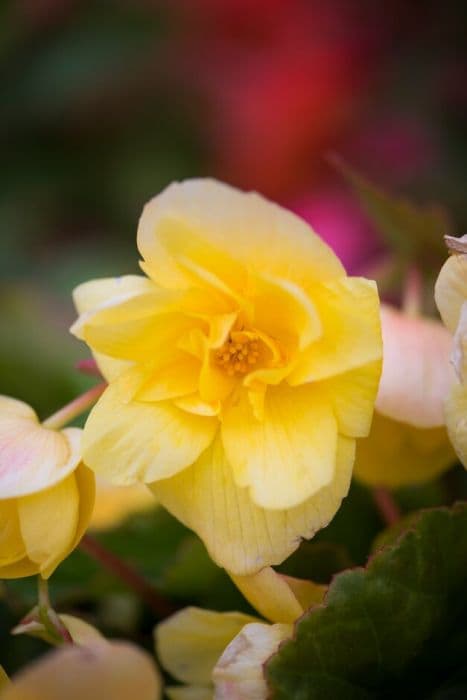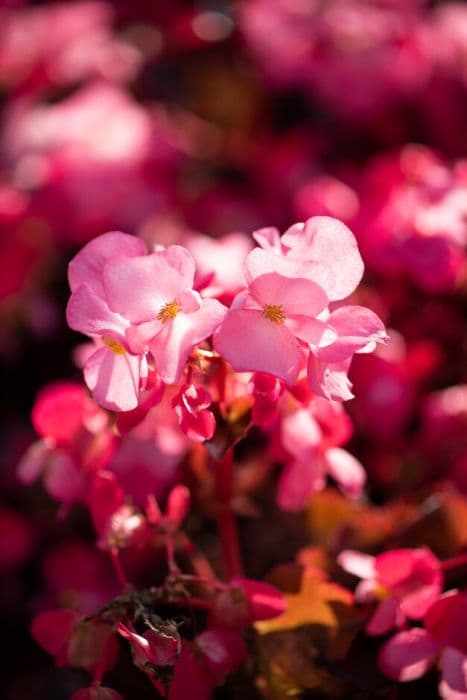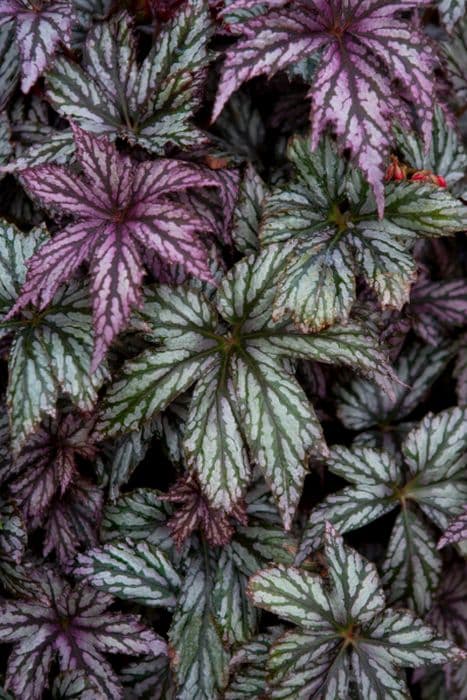Fireworks Begonia Begonia 'Fireworks' (R)

ABOUT
Begonia 'Fireworks' is a visually striking plant known for its vibrant foliar display. The leaves of this plant are the most noticeable feature, presenting a bold contrast of colors. They are typically star-shaped with sharply pointed tips and boast a palette of rich purples and greens. The upper surface of the leaf is adorned with a profusion of silvery-white speckles that radiate from the center, akin to the lines of a firework explosion, hence the name 'Fireworks.' This shimmery effect gives the plant a sparkly appearance, especially when seen under bright light. The undersides of the leaves present a reddish-purple hue which can add to the visual appeal of the plant when viewed from different angles. Adding to the aesthetic, the Begonia 'Fireworks' produces clusters of delicate flowers that can range in color from light pinks to whites, with each flower held aloft on thin yet sturdy stalks, complementing the showy foliage. These blossoms typically add a soft, subtle contrast to the dramatic leaves, making this plant a popular choice for indoor decoration.
About this plant
 Names
NamesFamily
Begoniaceae
Synonyms
Fireworks Begonia
Common names
Begonia 'Fireworks'
 Toxicity
ToxicityTo humans
Begonia, including the 'Fireworks' variety, is considered mildly toxic to humans if ingested. Symptoms may include irritation of the mouth, lips, tongue, and throat, difficulty in swallowing, and nausea. In rare cases, vomiting or diarrhea may also occur if parts of the plant are eaten in significant quantities. It's important to keep the Begonia 'Fireworks' out of reach of children who might accidentally ingest the plant.
To pets
Begonia, including the 'Fireworks' variety, is toxic to pets such as cats and dogs. The ingestion of this plant can lead to symptoms like drooling, vomiting, and difficulty swallowing due to the irritation of the oral mucous membranes. In severe cases, ingestion can result in kidney failure. It's crucial to prevent pets from chewing or ingesting any part of the plant.
 Characteristics
CharacteristicsLife cycle
Perennials
Foliage type
Evergreen
Color of leaves
Mixed
Flower color
Pink
Height
1-1.5 feet (30-45 cm)
Spread
1-1.5 feet (30-45 cm)
Plant type
Herb
Hardiness zones
10
Native area
Tropical South America
Benefits
 General Benefits
General Benefits- Ornamental Appeal: The striking foliage with variegated patterns of silver and purple adds visual interest to any indoor space or shaded garden area.
- Easy Care: Begonias are generally low maintenance, making them suitable for a variety of gardeners, from beginners to experts.
- Drought Tolerance: Once established, Begonia 'Fireworks' has a degree of drought tolerance, reducing the need for frequent watering.
- Shade Loving: This plant thrives in shaded areas, offering a beautiful option for spots in a garden where other plants might struggle.
- Compact Growth: It remains relatively compact, making it ideal for containers, hanging baskets or small gardens.
- Season-Long Color: It provides long-lasting color throughout the growing season, from spring to autumn.
 Medical Properties
Medical PropertiesThis plant is not used for medical purposes.
 Air-purifying Qualities
Air-purifying QualitiesThis plant is not specifically known for air purifying qualities.
 Other Uses
Other Uses- Begonia 'Fireworks' can be used in terrariums, providing a pop of color and texture among other moisture-loving plants due to their high humidity tolerance.
- The striking foliage of Begonia 'Fireworks' makes it an excellent choice for botanical art, such as leaf casting, where its intricate patterns can be preserved in a plaster-like medium.
- Pressed flower techniques can also incorporate Begonia 'Fireworks' leaves to create unique and colorful bookmarks, cards, or other paper-based crafts.
- For educational purposes, the distinct patterning of Begonia 'Fireworks' leaves can be used to teach principles of symmetry, vein structure, and color contrast in botany classes.
- Photographers might utilize the vivid leaves as a natural backdrop for macro photography subjects, enhancing the visual appeal with its fireworks-like appearance.
- Begonia 'Fireworks' can be used in floral corsages and boutonnieres for special events to add a tropical and exotic flair.
- During festive seasons, the colorful leaves can be incorporated into wreaths and garlands as a live alternative to traditional flowers or foliage.
- In boutique hotels or spas, Begonia 'Fireworks' potted plants could be used thematically in rooms or relaxation areas for their unique aesthetic and calming presence.
- The plant can be used as a natural dye source, with its pigments possibly producing unique hues for fabrics or art projects.
- In the culinary field, although not commonly consumed, the petals of Begonia 'Fireworks', if non-toxic, could potentially be used as a garnish for their vibrant colors and visual interest.
Interesting Facts
 Feng Shui
Feng ShuiThe Begonia is not used in Feng Shui practice.
 Zodiac Sign Compitability
Zodiac Sign CompitabilityThe Begonia is not used in astrology practice.
 Plant Symbolism
Plant Symbolism- Caution: Traditionally, begonias have been associated with warnings or alerts to potential dangers or misfortunes.
- Individuality: The 'Fireworks' variety, with its unique pattern and striking colors, represents embracing one's own uniqueness and standing out from the crowd.
- Harmony: The balanced growth and symmetry of the begonia blooms symbolize living in harmony with oneself and others.
- Gratitude: Giving begonias, like 'Fireworks', can express deep appreciation and thankfulness, making them a thoughtful gift.
 Water
WaterThe Begonia 'Fireworks' prefers consistent moisture but does not like to be waterlogged. Water when the top inch of soil feels dry to the touch, which typically means watering about once a week. Depending on the environmental conditions, such as heat and humidity, the frequency may need to be adjusted. Use room temperature water and avoid getting water on the leaves to prevent fungal diseases. For a potted Begonia 'Fireworks', watering with approximately 16 ounces of water should be sufficient to moisten the soil without causing standing water.
 Light
LightBegonia 'Fireworks' thrives in bright, indirect light. It's best placed in a location where it will receive filtered sunlight, such as near an east or north-facing window. Direct afternoon sun can be too intense and may scorch the leaves, so if the only available light is direct, consider using a sheer curtain to diffuse the sunlight.
 Temperature
TemperatureBegonia 'Fireworks' prefers to be kept at a temperature between 65°F and 75°F. It can tolerate a minimum temperature of 60°F but should not be exposed to temperatures below that, as cold can damage the plant. Avoid placing it in areas with drafts or sudden temperature changes.
 Pruning
PruningPruning the Begonia 'Fireworks' is necessary to maintain its shape and encourage fuller growth. Prune in the late winter or early spring, before the onset of new growth. Trim off any dead or dying leaves and stems, and cut back up to one-third of the plant to promote a bushy habit. Pruning should be done with clean, sharp scissors or pruners to ensure clean cuts and reduce the risk of disease.
 Cleaning
CleaningAs needed
 Soil
SoilFireworks Begonia thrives in a well-draining soil mix composed of peat moss, perlite, and pine bark in equal parts. The best pH range for this plant is between 5.5 and 6.5 to ensure proper nutrient uptake and avoid root damage.
 Repotting
RepottingFireworks Begonia should be repotted every 1-2 years to replenish the soil nutrients and accommodate root growth. It is best to repot in spring or early summer when the plant is in its active growth phase.
 Humidity & Misting
Humidity & MistingFireworks Begonia flourishes in high humidity conditions, ideally between 50% and 70%. This level of humidity supports healthy growth and vibrant foliage but avoid excessive humidity to prevent mold and rot.
 Suitable locations
Suitable locationsIndoor
Place in bright, indirect light, ensure good airflow, and maintain high humidity.
Outdoor
Shelter in partial shade, protect from harsh sun, and keep soil moist.
Hardiness zone
10-11 USDA
 Life cycle
Life cycleThe life of Begonia 'Fireworks' begins with seed germination, which occurs in warm, moist soil environments where the tiny seeds develop into seedlings. Upon reaching the seedling stage, the plant starts to grow its distinct foliage, with leaves exhibiting colorful patterns and a shimmering 'firework' appearance. As it matures, Begonia 'Fireworks' enters a vegetative stage, during which it expands in size and produces more leaves, becoming a full, bushy plant. During its blooming period, which can vary in timing depending on the climate and care, the plant produces clusters of delicate flowers that can add to the ornamental value. After flowering, if pollination occurs, the plant may produce seeds, enabling the cycle to begin anew, although many cultivars are commonly propagated through cuttings to maintain desirable traits. As a perennial, Begonias like 'Fireworks' can live for several years, with proper overwintering in colder climates, before eventually succumbing to age or environmental stresses.
 Propogation
PropogationPropogation time
Spring-Summer
The most popular method of propagating Begonia 'Fireworks' is through leaf cuttings. To do so, a healthy, mature leaf along with a portion of the stem is cut from the plant using a sharp, clean pair of scissors or a knife. The leaf should then be placed on a well-draining soil mixture, with the cut end of the stem slightly buried. It's essential to maintain a high humidity level around the leaf cutting, which can be achieved by covering it with a plastic bag or placing it in a propagator, but still ensuring some airflow to prevent rot. The soil should be kept consistently moist but not soggy. Roots typically begin to form within a few weeks, after which new growth will start to emerge, signaling the cutting has successfully taken. Once the new Begonia 'Fireworks' is well-established, it can be transplanted into a larger pot to continue growing.





![Begonia [Devotion]](/_next/image?url=https%3A%2F%2Fplants-admin.emdemapps.com%2Fimages%2Fplants%2F%2Fimages%2F604b58183573b.png&w=640&q=75)



